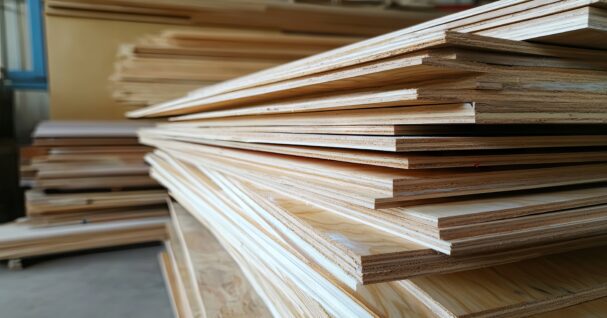
When it comes to building safe, code-compliant structures, choosing the right materials is crucial. One material that plays a big role in fire safety is fire-rated plywood. Whether you’re working on a residential home, commercial property, or industrial building, understanding when to use fire-rated plywood can help protect lives and property. Let’s take a closer look at what fire-rated plywood is, how it works, and when it’s essential.
What Is Fire-Rated Plywood?
Fire-rated plywood, also called fire-retardant treated wood, looks similar to standard plywood but is treated with chemical fire retardants under pressure to slow the spread of flames. The treatment doesn’t make it fireproof, but it significantly improves its resistance to burning. Fire-rated plywood is often tested against standards like ASTM E84, which measures how quickly flames and smoke spread. Products that meet a Class A fire rating have one of the slowest flame spread ratings, making them ideal for construction projects that prioritize fire safety.
Fire-rated plywood can be used for both structural and non-structural purposes, depending on the project’s needs and code requirements.
How Fire-Rated Plywood Works
Fire-rated plywood reacts differently when exposed to high heat. The chemicals inside the wood help it form a protective char layer on the surface during a fire. This char acts as a barrier, slowing the spread of flames and reducing smoke production. This gives occupants more time to evacuate and emergency crews more time to respond. Fire-rated plywood plays a key role in passive fire protection strategies, which limit fire spread without active systems like sprinklers.
Where Fire-Rated Plywood Is Commonly Used
Fire-rated plywood is required in many types of buildings and spaces where added fire resistance is critical. Common applications include:
- Residential Construction: Used in attached garages, stairwells, attic walls, and floors between units in multi-family homes.
- Commercial Buildings: Installed in hallways, corridors, lobbies, and elevator shafts where building codes require fire-rated assemblies.
- Industrial Facilities: Ideal for warehouses, factories, and storage units that house flammable materials or high-risk operations.
- Public Spaces: Often required in schools, hospitals, and government buildings to ensure safe evacuation in emergencies.
In some cases, even exterior walls or roofs in wildfire-prone areas must use fire-rated materials to meet local building codes. Always check the International Building Code (IBC) and local regulations to ensure compliance for your specific project.
Benefits of Using Fire-Rated Plywood
Choosing fire-rated plywood offers several key benefits beyond basic code compliance:
- Increased Fire Safety: Helps prevent fires from spreading rapidly, buying valuable evacuation time.
- Building Code Compliance: Essential for meeting fire safety regulations in both residential and commercial construction.
- Insurance Advantages: Some insurance providers offer lower premiums for structures built with fire-rated materials.
- Durability and Strength: Maintains essential strength for structural elements while enhancing fire resistance.
- Versatile Use: Available in different thicknesses and grades to suit a variety of project types.
By adding this extra layer of fire protection, builders and property owners can improve the overall safety and resilience of the structures they create.
When Should You Use Fire-Rated Plywood?
You should use fire-rated plywood whenever building codes or project specifications require it. However, there are other instances when it simply makes good sense:
- Code-Mandated Areas: Shared walls between living units, corridors, stairwells, and ceilings in multi-family or commercial buildings.
- High-Risk Zones: Kitchens, boiler rooms, utility areas, and other locations with a higher risk of fire.
- Public Access Spaces: Schools, hospitals, offices, and government buildings often have strict requirements for fire-rated materials.
- Wildfire-Prone Areas: Regions at risk for wildfires may mandate fire-resistant construction materials for home exteriors, roofs, and decks.
Even if not specifically required, adding fire-rated plywood in key areas can provide an extra level of safety that’s well worth the investment.
Choosing the Right Fire-Rated Plywood
Not all fire-rated plywood is created equal, so it’s important to choose carefully. Here’s what to look for:
- Certification: Ensure the plywood complies with ASTM E84 and carries a Class A flame spread rating.
- Proper Labeling: Materials should be clearly marked as fire-retardant treated, with information about their intended use (interior or exterior).
- Reputable Supplier: Buy from trusted suppliers who guarantee the performance and quality of their fire-rated products.
- Project Requirements: Make sure the plywood is rated for the specific applications — interior, exterior, structural, or non-structural — your project demands.
Choosing certified, high-quality fire-rated plywood ensures your construction meets legal requirements and maximizes safety.
Building Safer Projects with Fire-Rated Plywood
Fire-rated plywood plays an important role in creating safer, more resilient structures. Whether it’s protecting a home, a commercial building, or a large industrial facility, using fire-retardant materials helps safeguard lives and property when it matters most.
If you’re not sure which fire-rated plywood is right for your next project, Forest Plywood is here to help. Our knowledgeable team can guide you through the selection process and provide high-quality, code-compliant materials you can trust.



